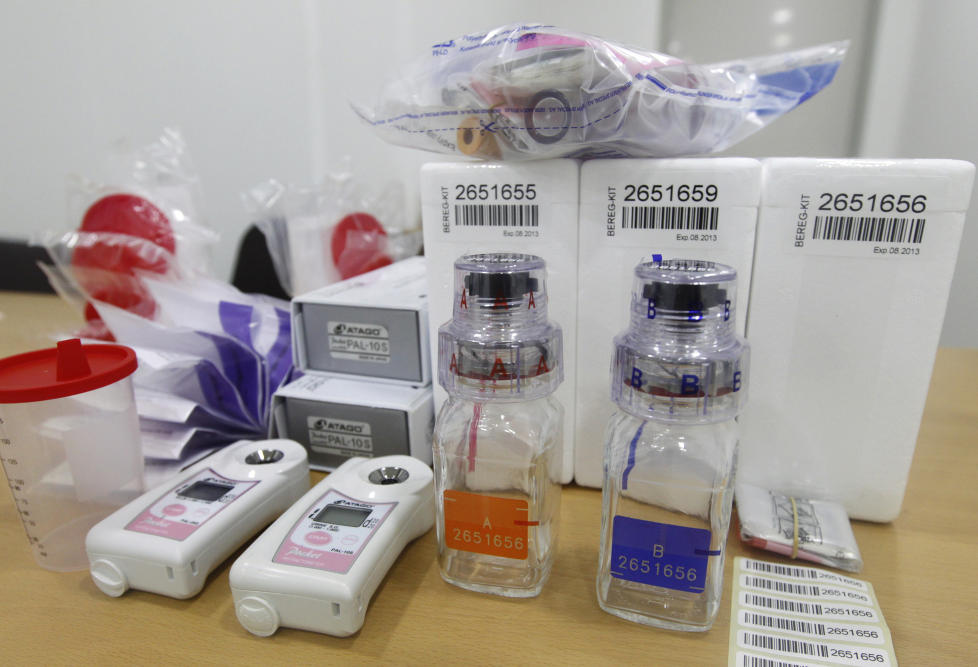
The scientific and anti-doping community continue to struggle with the development a test for exogenous growth hormone in athletes. They haven’t even been able to produce scientific evidence that growth hormone enhances athletic performance in spite of anecdotal evidence [from athletes and strength coaches] that this is the case.
But science continues to do a good job at finding weakness in the doping controls currently in place. Tip of the hat to Trust But Verify for alerting us of a new study which, among other things, tells us exactly how much exogenous testosterone some athletes can use and still pass the drug test.
The study reveals serious weaknesses in the testosterone:epitestosterone ratio test used by WADA and other anti-doping organizations (“Doping Test in Sports Confounded by Common Genetic Trait,” March 21).
The current first-line defense for detecting testosterone abuse in sports is to measure the ratio of two chemicals in a spot urine test: testosterone glucuronide (TG) and epitestosterone glucuronide (EG). TG is a by-product of testosterone in the body; it increases as the amount of testosterone increases. EG is unrelated to testosterone metabolism, and serves as a reference point in testing.
In doping tests, any ratio above four, according to the International Olympic Committee, should be considered suspicious and lead to further testing.
It appears that certain genotypes are more likely to have false negatives (athletes use testosterone but don’t get caught)and other genotypes are more likely to have false positives (innocent athletes test positive for steroid use).
The production of TG from testosterone, however, is primarily controlled by an enzyme (UGT2B17), which is produced by a specific gene. Common variations to this gene may give rise to wildly different testing results, even when the same dose of testosterone has been taken.
For their study, the researchers screened 145 men for the insertion (ins) or deletion (del) of this gene. Among the participants, 15 percent had no copies of the gene (del/del), 52 percent had one copy (ins/del), and 33 percent carried two copies (ins/ins).
From this group, the researchers selected 55 men (17 del/del, 24 ins/del, and 14 ins/ins) to receive a single 360 mg dose of testosterone. The men were then routinely tested over a 15-day period for the telltale signs of doping.
If you’re a genetically gifted athlete (i.e. you lack the gene that produces the enzyme UGT2B17), you can take an whopping injection of at least 360 milligrams of testosterone without getting caught by the testosterone:epitestosterone ratio test (T:E ratio). This testosterone loophole in drug testing has been known by athletes for decades (anecdotally). It is nice to have solid scientific evidence to confirm it.
A full 40 percent of the del/del subjects never reached the detection threshold in a standard doping test. “Nearly half of the individuals in our study who carried this genetic variation would go undetected in a regular doping test after a single 360 mg dose of testosterone,” said Dr. Schulze.
If you were born without the genetics to beat a drug test, then you have a fair chance of failing the drug test even if you are innocent.
Of equal interest, 14 percent of the ins/ins subjects were naturally over the detection threshold even without receiving a testosterone injection. Based on an earlier study, the researchers estimate that this would give a false-positive rate of 9 percent in a random population of young men. “False positive results are not only of concern for the legal rights of the sportsman,” said Dr. Schulze, “they also yield extra workload for the doping laboratories.”
Maybe athletes will start taking advantage of relatively inexpensive personal genome services to learn things like the likelihood of side effects from anabolic steroids and the likelihood of being able to get away with using banned substances?
Most importantly, this study provides solid evidence that innocent athletes can be falsely accused when relying on the T:E ratio test.
A few other things learned:
- A level playing field doesn’t exist even at the genotypic level even when it comes to the ability escape doping detection
- Could there be a rogue chemist who discovered a pharmaceutical drug that can block the UGT2B17 enzyme?
- Certain “ethnic populations” are more/less likely to get caught when using banned substances like testosterone (e.g. East Asians and Swedish Caucasians).
I look forward to reading the full text of the study when it is released.
The paper “Doping Test Results Dependent on Genotype of UGT2B17, the Major Enzyme for Testosterone Glucuronidation” will appear in the June issue of [Journal of Clinical Endocrinology & Metabolism]JCEM, a publication of The Endocrine Society.

About the author
Millard writes about anabolic steroids and performance enhancing drugs and their use and impact in sport and society. He discusses the medical and non-medical uses of anabolic-androgenic steroids while advocating a harm reduction approach to steroid education.

No replies yet
Loading new replies...
Join the full discussion at the MESO-Rx →